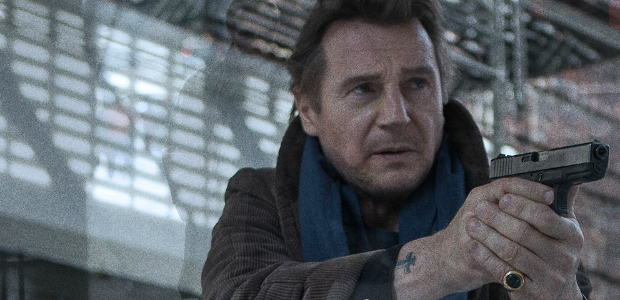Without going over the tipping point of just being “bad,” writer/director Scott Frank’s mystery thriller A Walk Among The Tombstones is a rather frustrating film. While it brings together a talented writer/director, a well-cast, strong lead in Liam Neeson, and cinematic source material well-suited for adaptation, it’s surprising how many missteps it takes, and though it ultimately largely works, it still feels like there’s a good deal of missed potential.
Based on the novel of the same name by Lawrence Block, A Walk Among The Tombstones operates in the spirit of classic, hard-boiled detective stories and stars Liam Neeson as Matt Scudder, a former cop/unlicensed private detective and recovering alcoholic living in New York at the turn of the 21st century. With a strong plot involving the wife of a drug trafficker (Dan Stevens) who is kidnapped and slaughtered, the film immediately engages the audience and motivates them to cheer on the hero as he hunts down the psychopaths responsible (following all kinds of dark twists and turns along the way). Unfortunately, it can’t rise above some deep-rooted flaws from the script, including a few too many overly familiar characters and pacing that is too loose for what should be a rigorously taut mystery. Here's an example. I understand that giving the hero a streetwise teen sidekick shines a different kind of light on his personality and adds a bit of levity to the movie, but it just feels extraneous when there so much else going on.
Sitting square between the film’s greatest successes and biggest failures is the interesting gamble it takes in its portrayal of the killers Scudder is looking for – which has its benefits and negatives. Rather than pulling the classic third act reveal, Scott Frank instead begins to hint at the identities of his villains right at the start, and actually lifts the veil completely in the middle of the movie (though I still won’t spoil who they are here). On the plus side, the writer/director cast the roles immensely well, as every time the monsters are on screen, there is a chill that goes down your spine. There is, however, a degree to which some of the narrative thrust is lost after the murderers are shown. The audience is no longer tracking the hero as he hunts for a pair of mysterious psychopaths. Instead, we're just waiting for the protagonists and antagonists to finally come face to face. Like the rest of A Walk Among The Tombstones, it’s a mixed bag.
Given that Scudder is in practically every scene and is the vessel through which audiences see the story unfold, Liam Neeson is obviously a very important part of the film. But his presence comes with an extra bonus: it’s just plain entertaining to see him play the classic private detective role. His gruff, surly demeanor lends perfectly to the role, and the way he questions witnesses, tough talks punks and gets smart around cops feels perfectly natural. There are shades of the token “older badass” character, which has fueled the actor’s career since Taken. But Matt Scudder is a reasonably more complex portrayal to which Neeson successfully lends his own personal brand of gravitas.
Scott Frank is certainly better known in Hollywood for his work as a writer – from his fantastic Elmore Leonard adaptations Get Shorty and Out of Sight, to Steven Spielberg’s blockbuster Minority Report – but A Walk Among The Tombstones demonstrates his developing eye as a director since making his debut with 2007’s The Lookout. He and cinematographer Mihai Malaimare Jr. have worked together to create a dingy late-90s New York City that elegantly matches the film’s dark tone and subject matter (see if you can count the number of Y2K references), and Scott makes regular use of odd angles to both enrich the mood of scenes and offer interesting perspectives (a fun tool in a detective story).
A Walk Among The Tombstones is the kind of movie that audiences will go back and forth on, as its positives and negatives do their part to weigh against each other. The interesting and compelling aspects of the narrative are somewhat drowned out by the worst parts, but the engaging characters and relationships also help overshadow the stock ones. It’s worth seeing if the story, leads and filmmakers interest you, but you’ll also wonder why it wasn’t better.
Your Daily Blend of Entertainment News

Eric Eisenberg is the Assistant Managing Editor at CinemaBlend. After graduating Boston University and earning a bachelor’s degree in journalism, he took a part-time job as a staff writer for CinemaBlend, and after six months was offered the opportunity to move to Los Angeles and take on a newly created West Coast Editor position. Over a decade later, he's continuing to advance his interests and expertise. In addition to conducting filmmaker interviews and contributing to the news and feature content of the site, Eric also oversees the Movie Reviews section, writes the the weekend box office report (published Sundays), and is the site's resident Stephen King expert. He has two King-related columns.

